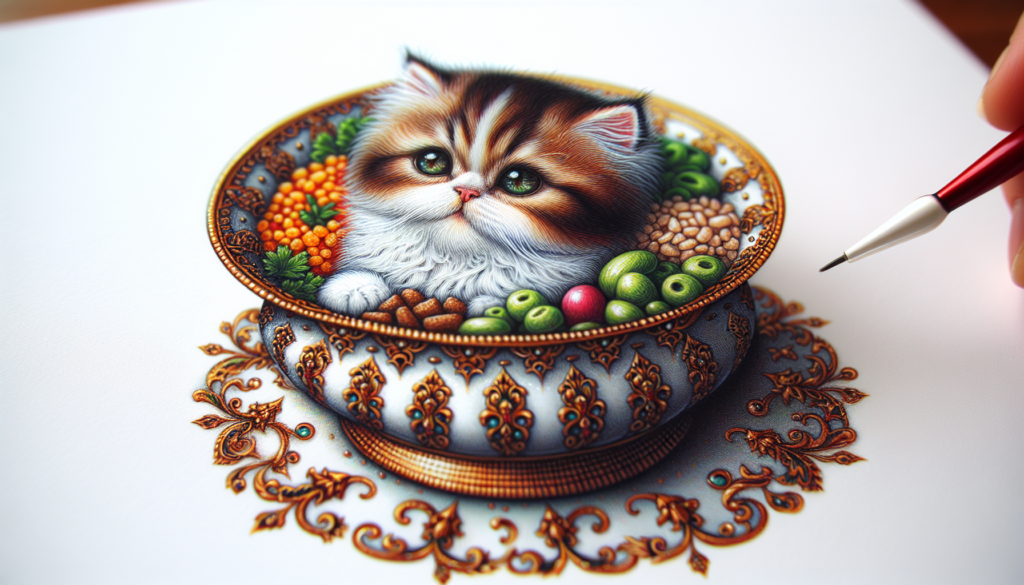Are you a proud owner of a Persian kitten? If so, you surely want to ensure your little feline friend gets the best nutrition. In our article, “What To Feed Persian Kittens,” we will guide you through the essential aspects of their diet, shedding light on the specific dietary needs that these adorable furballs require. From the right balance of protein, fats, and carbohydrates to the importance of hydration, we’ve got you covered with expert advice and handy tips to keep your Persian kitten healthy and thriving. So grab a cozy spot and get ready to learn all about the purr-fect diet for your precious little one.
What To Feed Persian Kittens
If you’re lucky enough to have a Persian kitten as a furry companion, you’ll want to make sure you provide them with the best nutrition possible. Feeding your Persian kitten the right food is crucial for their overall health and well-being. In this article, we will explore the types of food suitable for Persian kittens, factors to consider when choosing their food, the feeding schedule that works best, how to introduce solid food, and address specific health concerns that may arise.
Types of Food for Persian Kittens
When it comes to feeding Persian kittens, there are three main types of food to consider: wet food, dry food, and homemade food. Each has its own set of advantages and considerations, so let’s take a closer look at each option.
1. Wet Food
Wet food, also known as canned food, is a popular choice for Persian kittens due to its high moisture content. It provides the necessary hydration that helps prevent urinary tract issues, which is a common concern for Persian cats. Additionally, wet food tends to be more palatable and easier to consume, especially for kittens with smaller jaws and teeth.
When selecting wet food for your Persian kitten, opt for a high-quality brand that contains essential nutrients, such as proteins, vitamins, and minerals. It’s essential to read the label and ensure that the wet food meets the nutritional needs of your growing kitten.
2. Dry Food
Dry food, also referred to as kibble, is another option for feeding Persian kittens. It offers convenience and can help maintain dental health by promoting chewing and reducing tartar build-up. Dry food tends to have a longer shelf life and can be left out for free feeding. However, it is crucial to ensure your Persian kitten is drinking an adequate amount of water to prevent dehydration.
Similar to wet food, it is important to choose a high-quality brand of dry food specifically formulated for kittens. Look for a product that contains a balanced blend of proteins, fats, and carbohydrates to meet their nutritional needs.
3. Homemade Food
Some pet owners may choose to prepare homemade food for their Persian kittens. While this allows for full control over the ingredients, it is essential to ensure that the homemade meals are balanced and meet the nutritional requirements of your kitten. Consult with a veterinarian or a veterinary nutritionist to ensure you are providing the right combination of proteins, carbohydrates, vitamins, and minerals.
Factors to Consider When Choosing Food
When selecting the best food for your Persian kitten, there are several important factors to consider.
1. Nutritional Needs
Persian kittens have specific nutritional needs that are different from adult cats. They require a diet that is high in proteins for proper growth and development, as well as vitamins and minerals for overall health. Ensure that the food you choose meets these nutritional requirements and is specifically formulated for kittens.

2. Age and Development Stage
Your Persian kitten’s age and development stage are crucial considerations when selecting their food. Younger kittens may require softer food that is easier to chew and digest. As they grow, their food can gradually transition to more solid options. Always follow the feeding guidelines provided by the manufacturer and consult with your veterinarian to determine the appropriate food based on their age and development stage.
3. Allergies and Sensitivities
Just like humans, some kittens may suffer from food allergies or sensitivities. Monitor your Persian kitten for any signs of allergies, such as excessive scratching, digestive issues, or skin problems, and consult with your vet if you suspect any food-related allergies. It may be necessary to switch to a diet that avoids the allergen or undergo an elimination diet to determine the specific triggers.
Feeding Schedule for Persian Kittens
Establishing a feeding schedule is important to ensure your Persian kitten receives the necessary nutrients while preventing overfeeding. Here are some key points to consider for their feeding schedule.
1. Age-Appropriate Schedule
As your Persian kitten grows, their feeding schedule will change. When they are very young, they may require more frequent small meals. As they get older, their meals can be spaced out and reduced in frequency. Consult with your veterinarian for a specific feeding schedule suitable for your Persian kitten’s age.
2. Portion Control
Portion control is vital to prevent overeating and obesity. Follow the feeding guidelines provided by the manufacturer based on your kitten’s age and weight. If your Persian kitten tends to overeat, consider utilizing puzzle feeders or slow-feed bowls to encourage slower consumption.
3. Monitoring Weight and Adjusting Portions
Regularly monitor your Persian kitten’s weight to ensure they are maintaining a healthy weight range. If your kitten is gaining weight too quickly or appears to be underweight, consult with your veterinarian to adjust their portion sizes accordingly.

4. Scheduled Feedings vs. Free Feeding
Scheduled feedings involve giving your Persian kitten specific meals at designated times throughout the day. This method allows for portion control and regulation of their diet. Free feeding, on the other hand, involves leaving food available at all times. While convenient, free feeding can lead to overeating and potential weight issues. Consult with your veterinarian to determine the best feeding method for your Persian kitten.
Introducing Solid Food to Persian Kittens
When it’s time to transition your Persian kitten from milk to solid food, it’s important to proceed with care. Here are some tips to make the process smoother.
1. Transitioning from Milk to Solid Food
Around four to six weeks of age, Persian kittens can begin the process of weaning. Offer a small amount of soft or wet food mixed with formula or water at first. Gradually decrease the formula or water ratio until your kitten is fully transitioned to solid food.
2. Tips for a Smooth Transition
To ensure a smooth transition, make sure the food is easily chewable and suitable for your kitten’s age. You can moisten dry food to make it softer and more palatable. Offer small and frequent meals initially, gradually increasing the portion size and reducing the feeding frequency as your kitten adapts.
3. Monitoring Kittens’ Reactions
During the transition phase, closely monitor your Persian kitten for any signs of digestive upset. If your kitten experiences loose stools, vomiting, or refuses to eat, it’s important to consult with your veterinarian for guidance. They may suggest adjusting the type or brand of food to better suit your kitten’s needs.
4. Gradual Introduction of New Foods
As your Persian kitten grows, you may want to introduce a variety of foods to their diet. When introducing new foods, do it slowly and gradually to avoid digestive upset. Mix a small portion of the new food with their current food and gradually increase the proportion over several days.
Addressing Specific Health Concerns
In addition to their regular diet, there are specific health concerns that you should address when feeding your Persian kittens.
1. Hairball Prevention
Due to their long and luxurious fur, Persian kittens are prone to hairballs. Including a hairball prevention formula or providing specific hairball control supplements can help reduce the frequency and severity of hairballs.
2. Dental Health
Maintaining good dental health is crucial for Persian kittens. Dry food and specially formulated dental treats can help promote chewing, reduce tartar build-up, and maintain healthy teeth and gums.
3. Urinary Tract Health
Urinary tract issues, such as urinary crystals or infections, can be a concern for Persian kittens. Providing wet food and ensuring they have access to fresh water can help promote urinary tract health and prevent such issues.
4. Food for Persians with Sensitive Stomachs
Some Persian kittens may have sensitive stomachs and be prone to digestive issues. If your kitten frequently experiences diarrhea, vomiting, or bloating, consider switching to a specialized diet formulated for sensitive stomachs under the guidance of your veterinarian.
Conclusion
Feeding your Persian kitten a nutritious and balanced diet is essential for their overall health and well-being. Remember to consider their nutritional needs, age, allergies, and sensitivities when selecting the best food. Establish a feeding schedule, monitor their weight, and introduce solid food gradually. Address specific health concerns such as hairballs, dental health, urinary tract health, and sensitive stomachs. By providing your Persian kitten with the right food, you are setting them up for a healthy and happy life.
